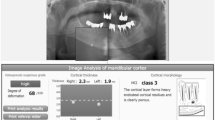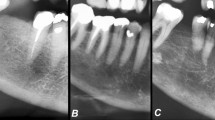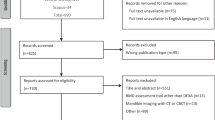Abstract
Summary
This study assessed the relationship between the mandibular inferior cortex (MIC) and bone stiffness in elderly Japanese subjects. Results suggest that MIC classification may be useful for screening patients for the possibility of osteoporosis by measuring bone stiffness with ultrasound bone densitometry.
Introduction
The prevention of fractures is a priority for patients with osteoporosis. Dental panoramic radiographs are frequently taken for the examination of teeth and jaws in general dental practice worldwide. This study assessed the relationship between the mandibular inferior cortex (MIC) and bone stiffness in elderly Japanese subjects.
Methods
This study included 519 healthy subjects (263 men and 256 women) aged 70 years old. We evaluated the relationship between MIC classification and bone stiffness using Scheffe’s multiple comparison test. Multiple linear regression analysis was used to assess the relationship between MIC classification and bone stiffness after controlling for confounding factors.
Results
A significant correlation was found between MIC classification and bone stiffness in men (C1 vs C2: p < 0.05) and women (C1 vs C2: p = NS, C1 vs C3: p < 0.01, C2 vs C3: p < 0.05). MIC classification was significantly associated with bone stiffness on multiple linear regression analysis after controlling for sex, body mass index, regular exercise, and smoking (β = −0.11, p < 0.01, R 2 = 0.387, p < 0.001).
Conclusions
Our study suggests that MIC classification may be useful for screening patients for the possibility of osteoporosis by measuring bone stiffness with ultrasound bone densitometry.


Similar content being viewed by others
References
European Foundation for Osteoporosis and the National Osteoporosis Foundation (1997) Who are candidates for prevention and treatment for osteoporosis? Osteoporos Int 7:1–6
Randell A, Sambrook PN, Nguyen TV et al (1995) Direct clinical and welfare costs of osteoporotic fractures in elderly men and women. Osteoporos Int 5:427–32
Cooper C, Campion G, Melton LJ III (1992) Hip fractures in the elderly: a worldwide projection. Osteoporos Int 2:285–89
Freedman KB, Kaplan FS, Bilker WB et al (2000) Treatment of osteoporosis: are physicians missing an opportunity? J Bone Joint Surg Am 82:1063–70
Siris ES, Miller PD, Barrett-Connor E et al (2001) Identification and fracture outcomes of undiagnosed low bone mineral density in postmenopausal women: results from the National Osteoporosis Risk Assessment. JAMA 286:2815–22
Shimano T, Suzuki Y, Sasaki T (2002) Long-term trend of dental radiographic examination in Japan-analysis on health insurance data. Dent Radiol 42:9–21 (in Japanese)
Taguchi A, Tsuda M, Ohtsuka M et al (2006) Use of dental panoramic radiographs in identifying younger postmenopausal women with osteoporosis. Osteoporos Int 17:387–94
Klemetti E, Kolmakov S, Kroger H (1994) Pantomography in assessment of the osteoporosis risk group. Scand J Dent Res 102:68–72
Taguchi A, Suei Y, Sanada M et al (2003) Detection of vascular disease risk in women by panoramic radiography. J Dent Res 82:838–43
Bollen A-M, Taguchi A, Hujoel PP et al (2000) Case control study on self reported osteoporotic fractures and mandibular cortical bone. Oral Surg Oral Med Oral Pathol Oral Radiol Endod 90:518–24
Deguchi T, Yoshihara A, Hanada N et al (2007) Relationship between mandibular inferior cortex and general bone metabolism in older adults. Osteoporos Int 19:935–40
Nguyen TV, Kelly PJ, Sambrook PN et al (1994) Lifestyle factors and bone density in the elderly: implications for osteoporosis prevention. J Bone Miner Res 9:1339–46
Law MR, Hackshaw AK (1997) A meta-analysis of cigarette smoking, bone mineral density and risk of hip fracture: recognition of a major effect. BMJ 315:841–46
Hannan MT, Felson DT, Dawson-Hughes B et al (2000) Risk factors for longitudinal bone loss in elderly men and women: the Framingham Osteoporosis Study. J Bone Miner Res 15:710–20
Ravn P, Cizza G, Bjarnason NH et al (1999) Low body mass index is an important risk factor for low bone mass and increased bone loss in early postmenopausal women. Early Postmenopausal Intervention Cohort (EPIC) study group. J Bone Miner Res 14:1622–27
Nguyen TV, Sambrook PN, Eisman JA (1998) Bone loss, physical activity, and weight change in elderly women: the Dubbo Osteoporosis Epidemiology Study. J Bone Miner Res 13:1458–67
Park H, Togo F, Watanabe E et al (2007) Relationship of bone health to year long physical activity in older Japanese adults: cross-sectional data from the Nakanojo study. Osteoporos Int 18:285–93
Koyano W, Shibata H, Nakazato K et al (1991) Measurement of competence: reliability and validity of the TMIG Index of Competence. Arch Gerontol Geriatr 13:103–116
Lunar Corporation (1991) Theory of ultrasound densitometry. In: Lunar Corporation (ed) Manual of Achilles Ultrasound Bone Densitometer. Lunar, Madison, pp B1–B7
Maugeri D, Santangelo A, Abbate S et al (2001) Correlation between the bone mass, psychometric performances, and the levels of autonomy and autosufficiency in an elderly Italian population above 80 years of age. Arch Gerontol Geriatr 33:265–71
Taguchi A, Suei Y, Ohtsuka M et al (1996) Usefulness of panoramic radiography in the diagnosis of postmenopausal osteoporosis in women. Width and morphology of inferior cortex of the mandible. Dentomaxillofac Radiol 25:263–67
Cummings SR, Black DM, Nevitt MC et al (1993) Bone density at various sites for prediction of hip fractures. Lancet 341:72–75
Nevitt MC, Johnell O, Black DM et al (1994) Bone mineral density predicts non-spine fractures in very elderly women. Osteoporos Int 4:325–31
Cheng S, Suominen H, Era P et al (1994) Bone density of the calcaneus and fractures in 75- and 80-year-old men and women. Osteoporos Int 4:48–54
Hans D, Schott AM, Duboeuf F, Durosier C, Meunier PJ et al (2004) Does follow-up duration influence the ultrasound and DXA prediction of hip fracture? The EPIDOS prospective study. Bone 35:357–63
Horner K, Karayianni K, Mitsea A et al (2007) The mandibular cortex on radiographs as a tool for osteoporosis risk assessment: the OSTEODENT project. J Clin Densitom 10:138–46
Drozdzowska B, Pluskiewiez W, Tarnawska B (2002) Panoramic-based mandibular indices in relation to mandibular bone density and skeletal status assessed by dual energy X-ray absorptiometry and quantitative ultrasound. Dentomaxillofac Radiol 31:361–7
Taguchi A, Ohtsuka M, Nakamoto T et al (2007) Identification of post-menopausal women at risk of osteoporosis by trained general dental practitioners using panoramic radiographs. Dentomaxillofac Radiol 36:149–54
Tugnait ACV, Hirschmann PN (2003) Radiographic equipment and techniques used in general dental practice: a survey of general dental practitioners in England and Wales. J Dent 31:197–203
Watanabe PCA, Issa JPM, Oliveira TM et al (2007) Morphodigital study of the mandibular trabecular bone in panoramic radiographs. Int J Morphol 25:875–80
Acknowledgments
This work was supported by Grant-in-Aids from the Japan Society for the Promotion of Science (No.17592177) and from the Ministry of Health and Welfare of Japan (H10-Iryo-001).
Conflicts of interest
None.
Author information
Authors and Affiliations
Corresponding author
Rights and permissions
About this article
Cite this article
Kiswanjaya, B., Yoshihara, A., Deguchi, T. et al. Relationship between the mandibular inferior cortex and bone stiffness in elderly Japanese people. Osteoporos Int 21, 433–438 (2010). https://doi.org/10.1007/s00198-009-0996-9
Received:
Accepted:
Published:
Issue Date:
DOI: https://doi.org/10.1007/s00198-009-0996-9




